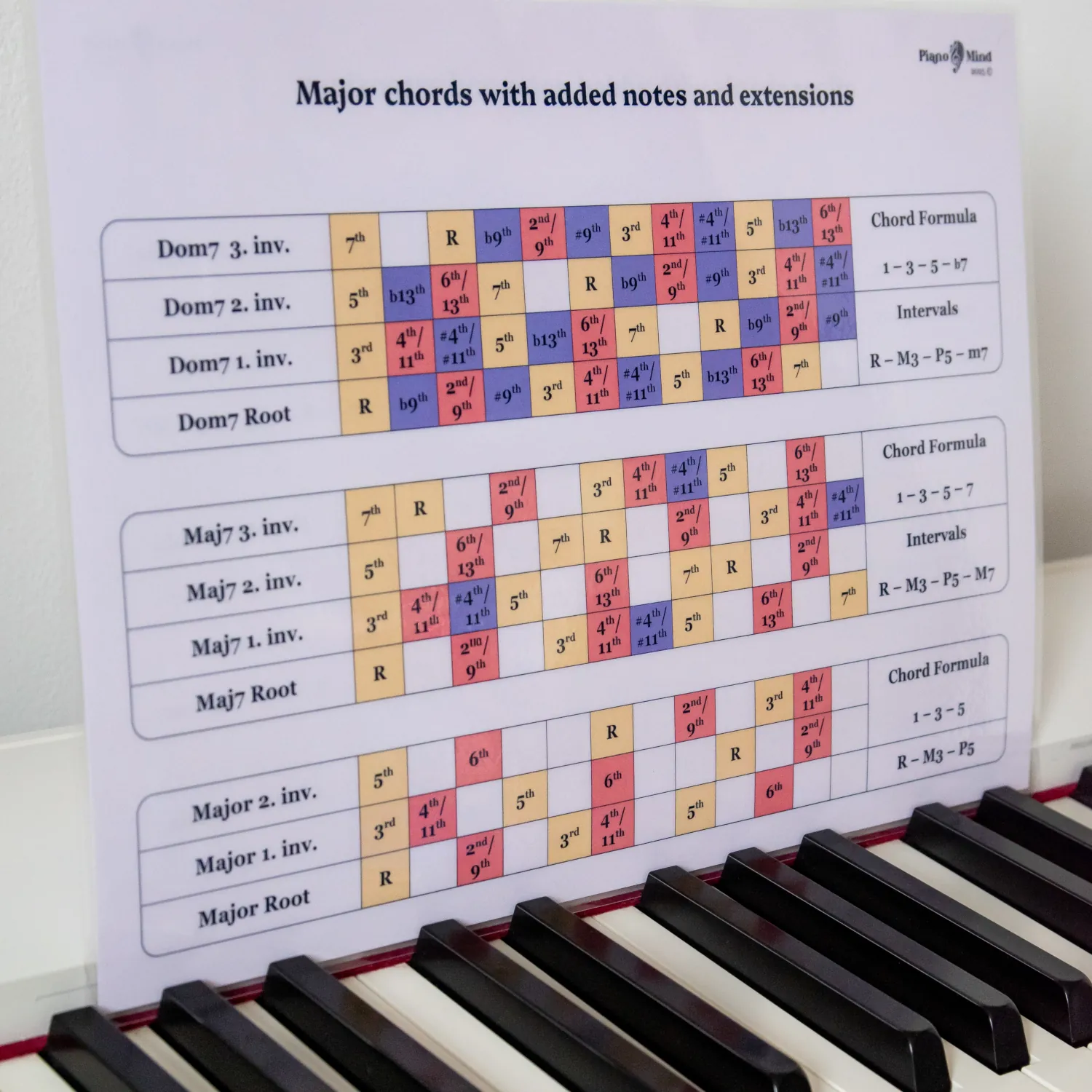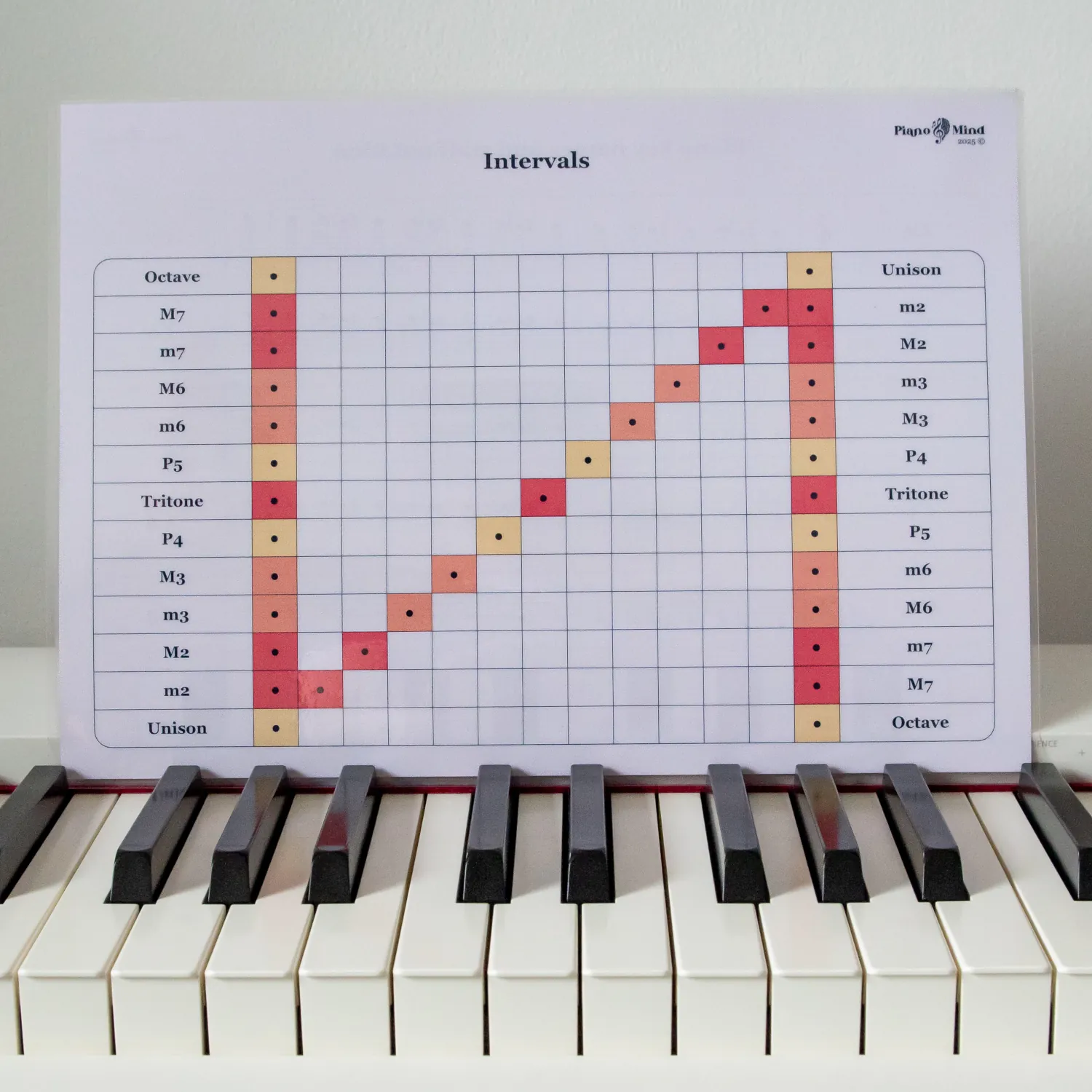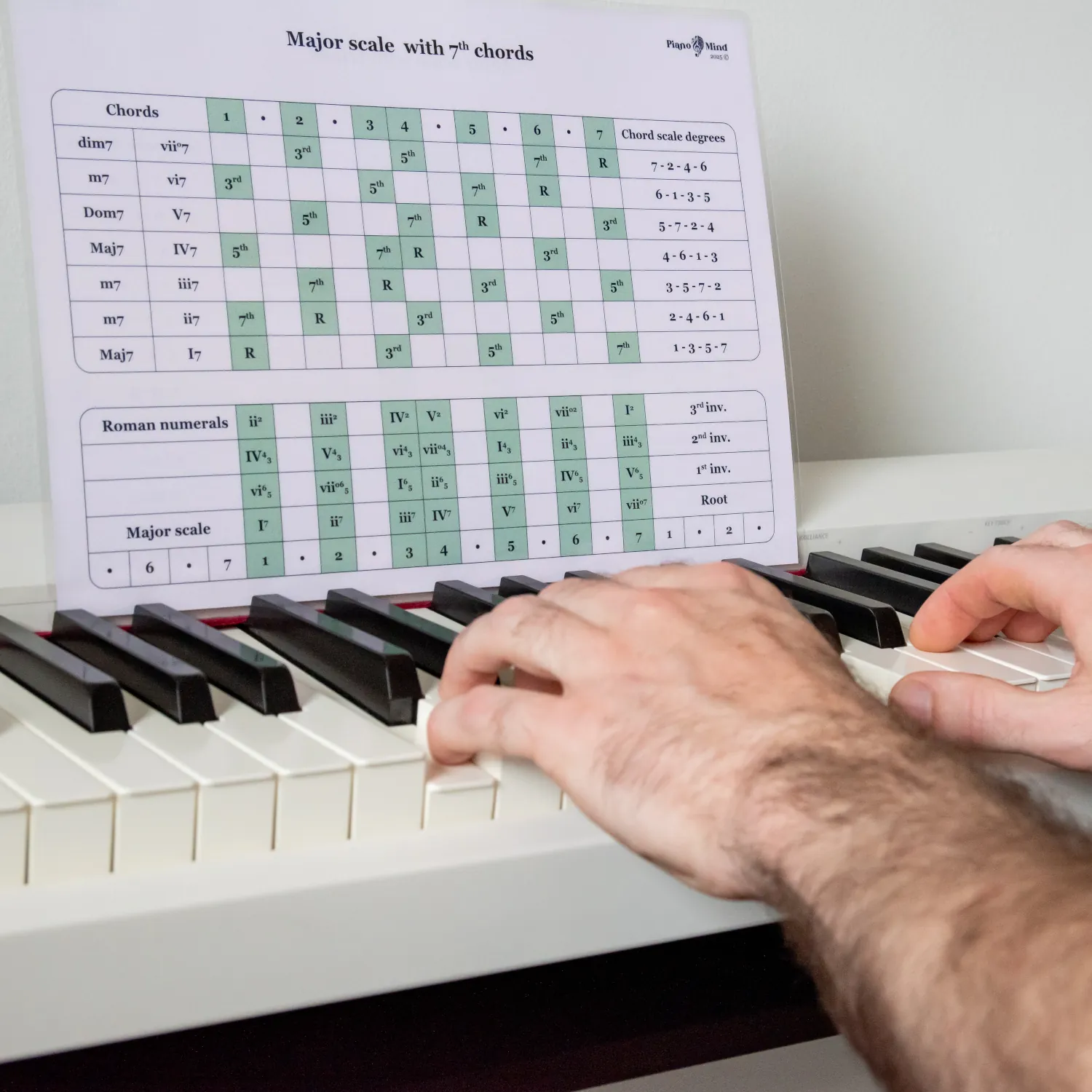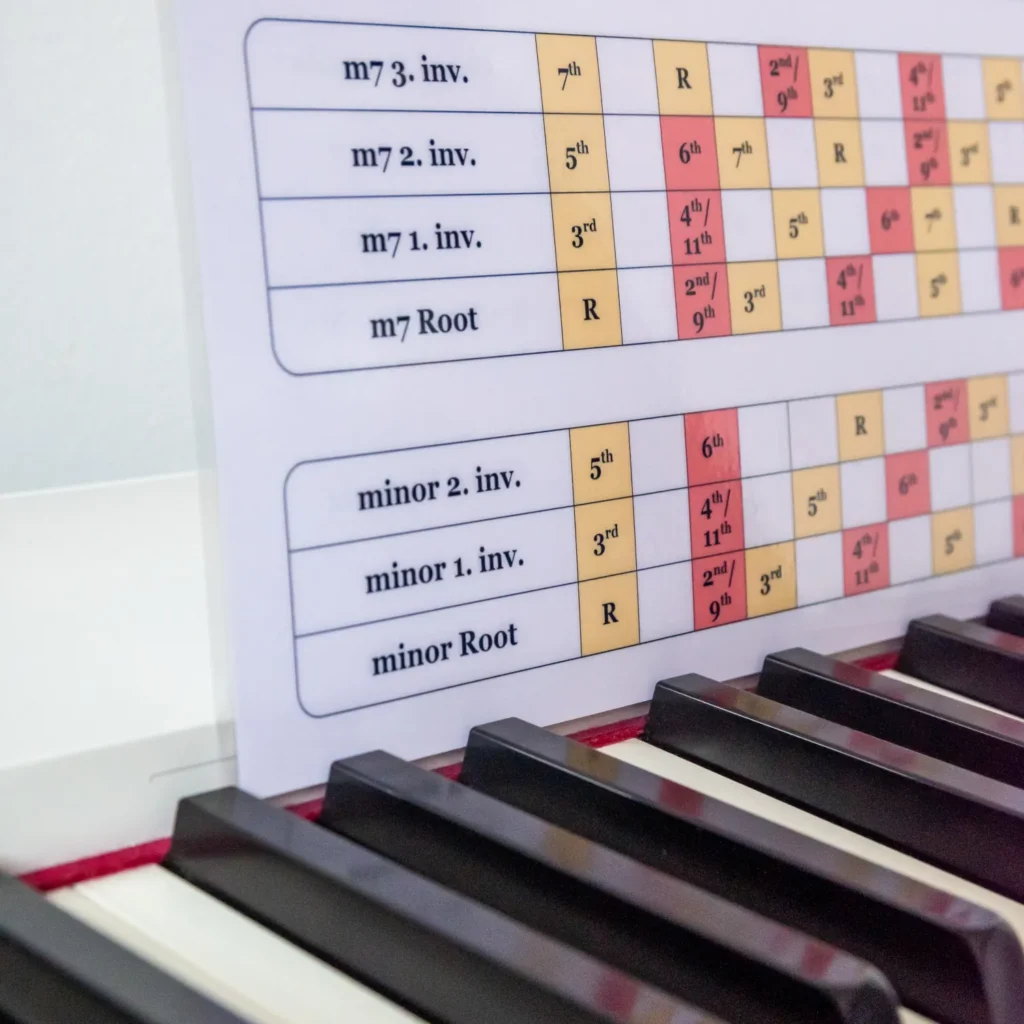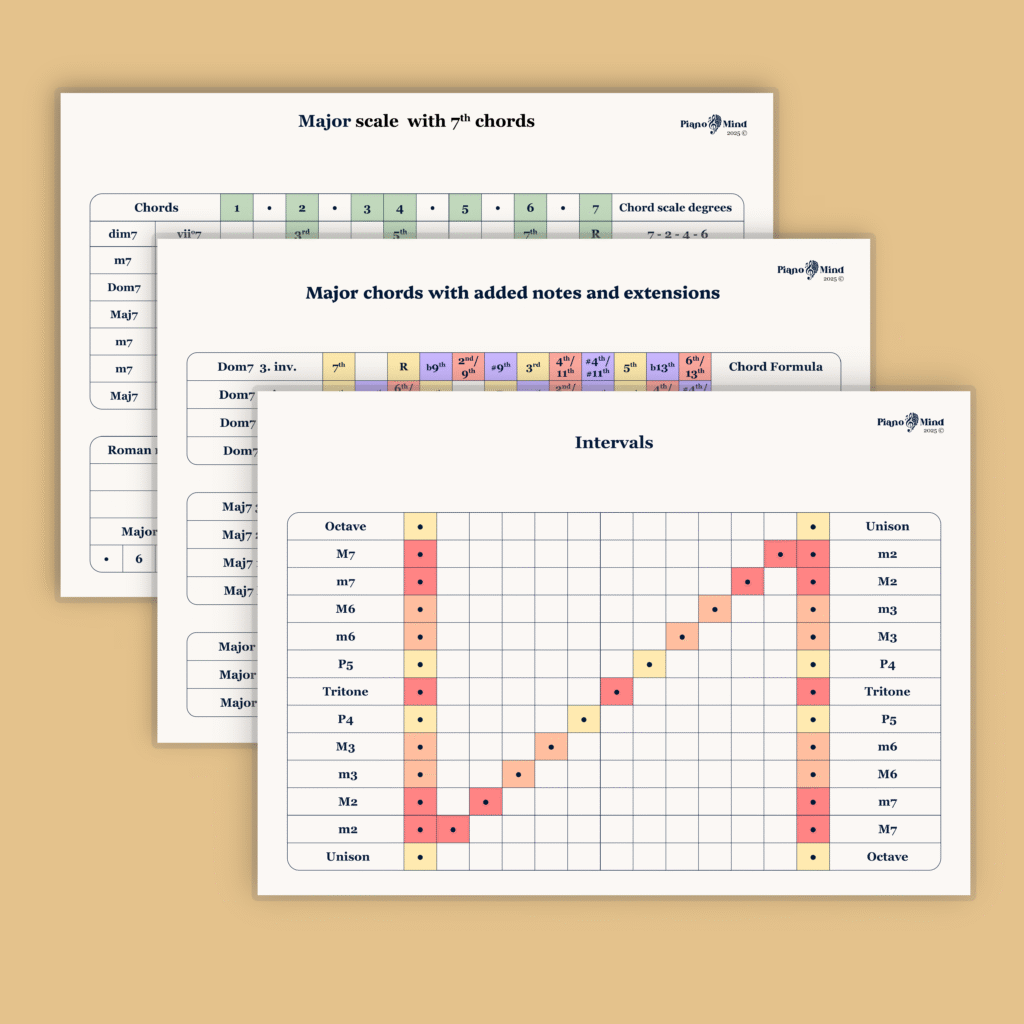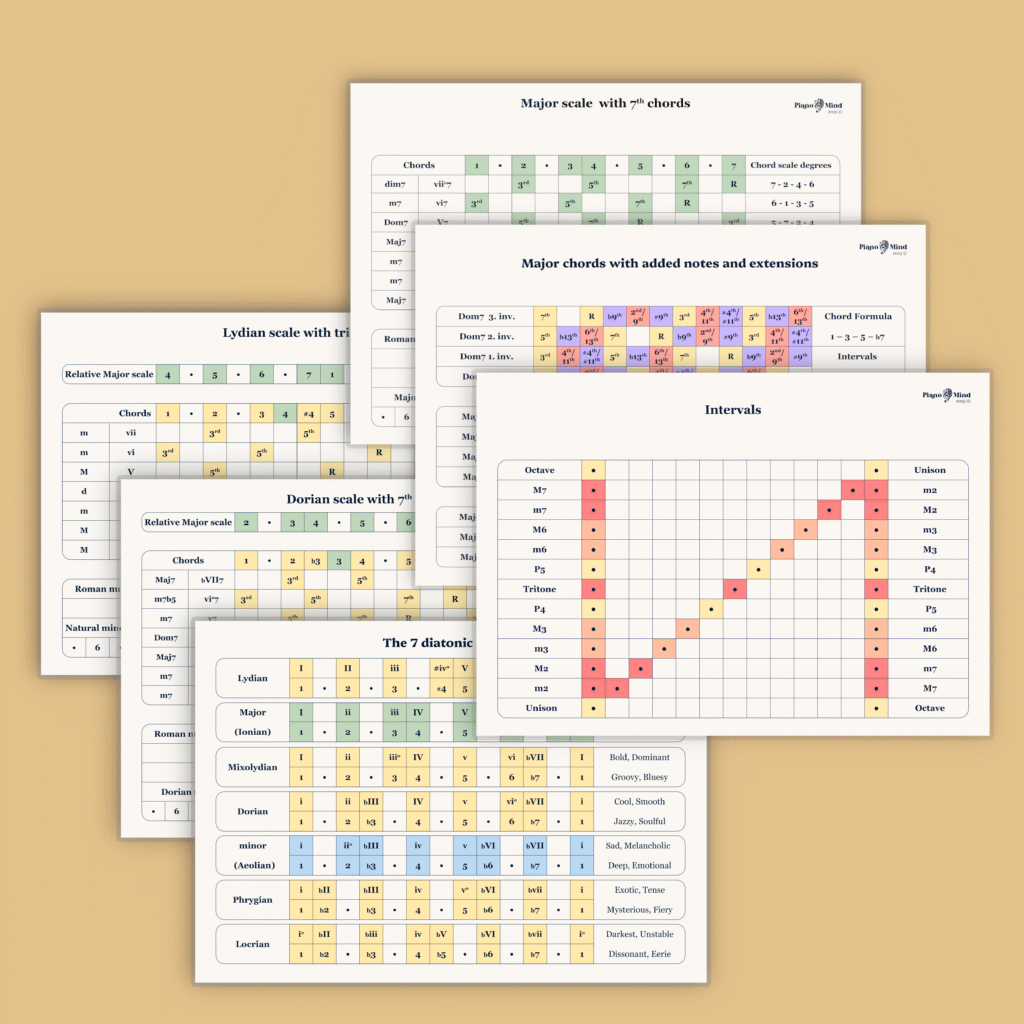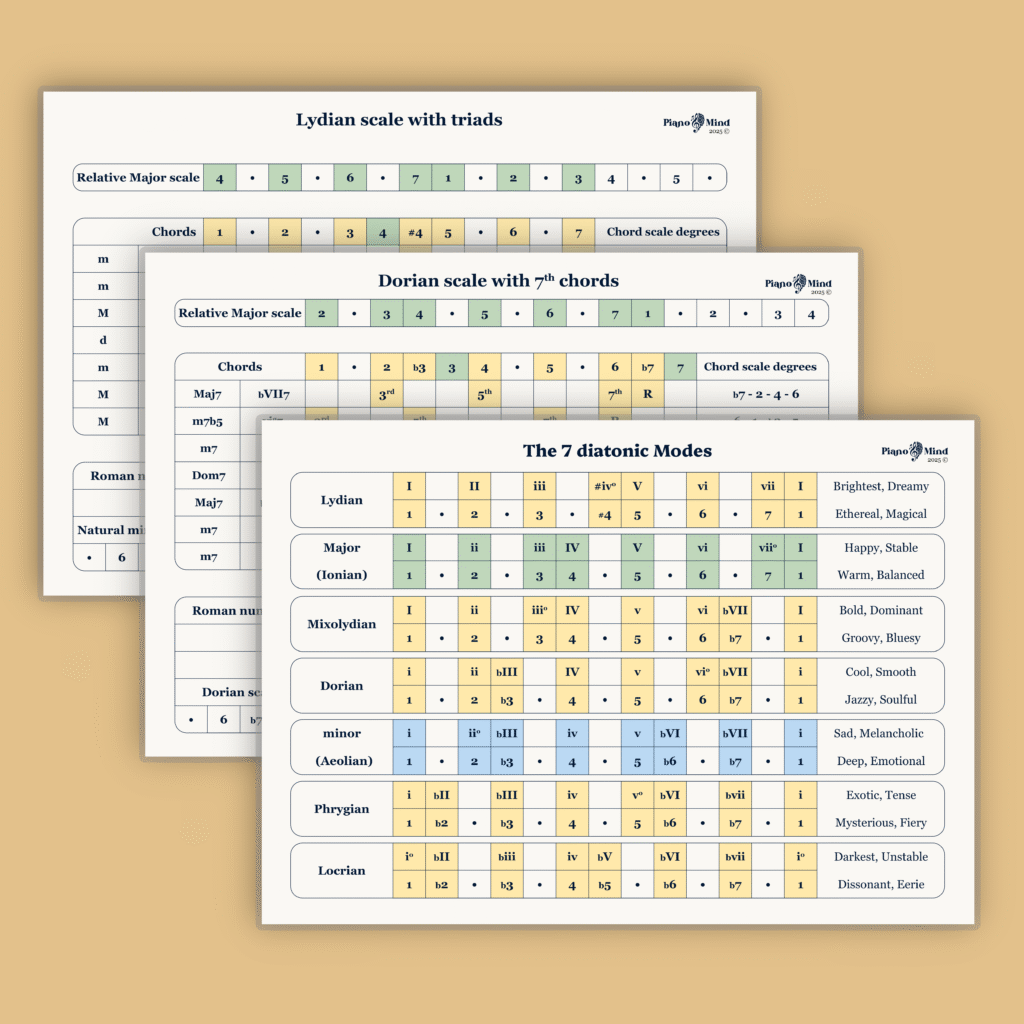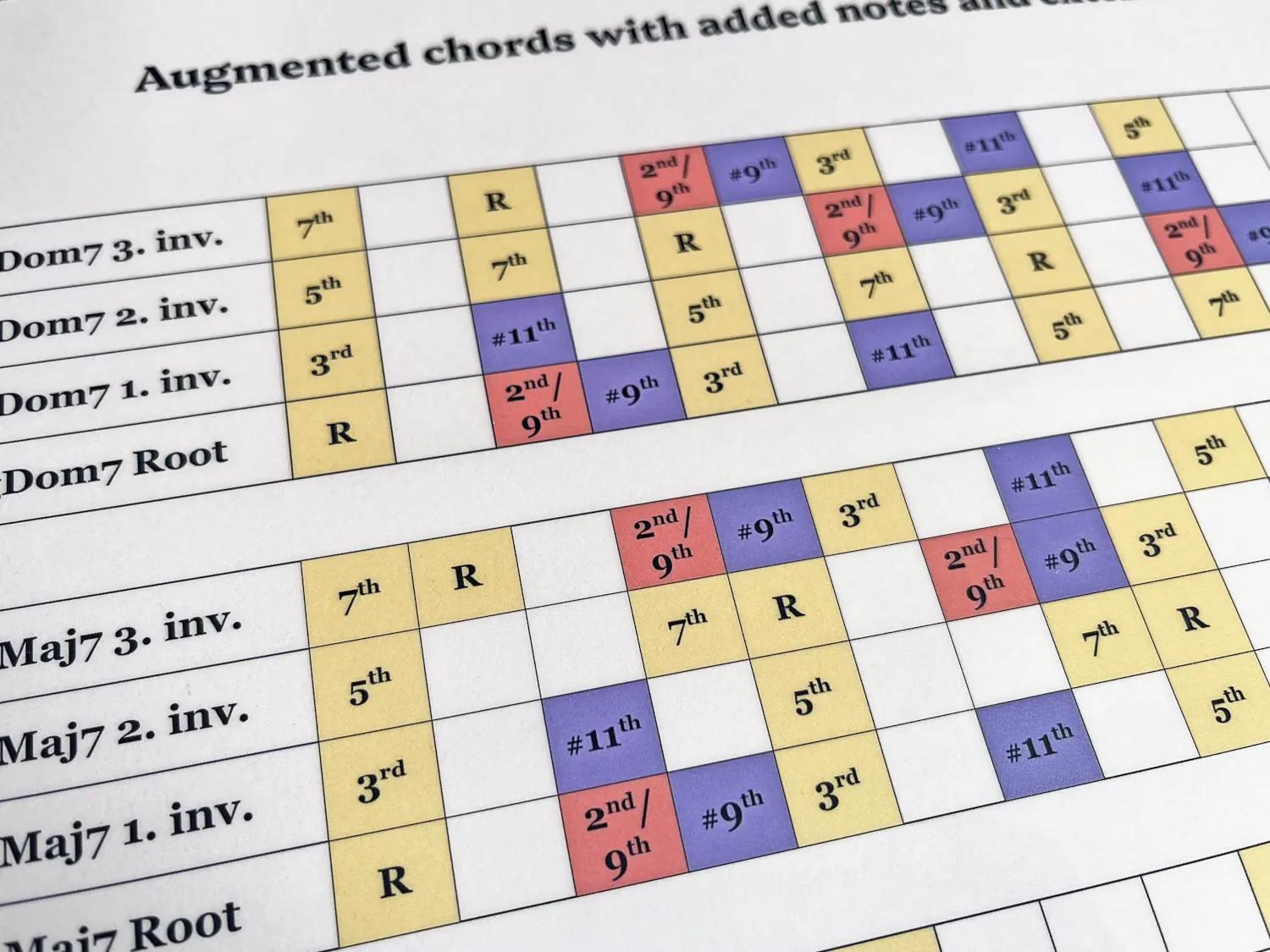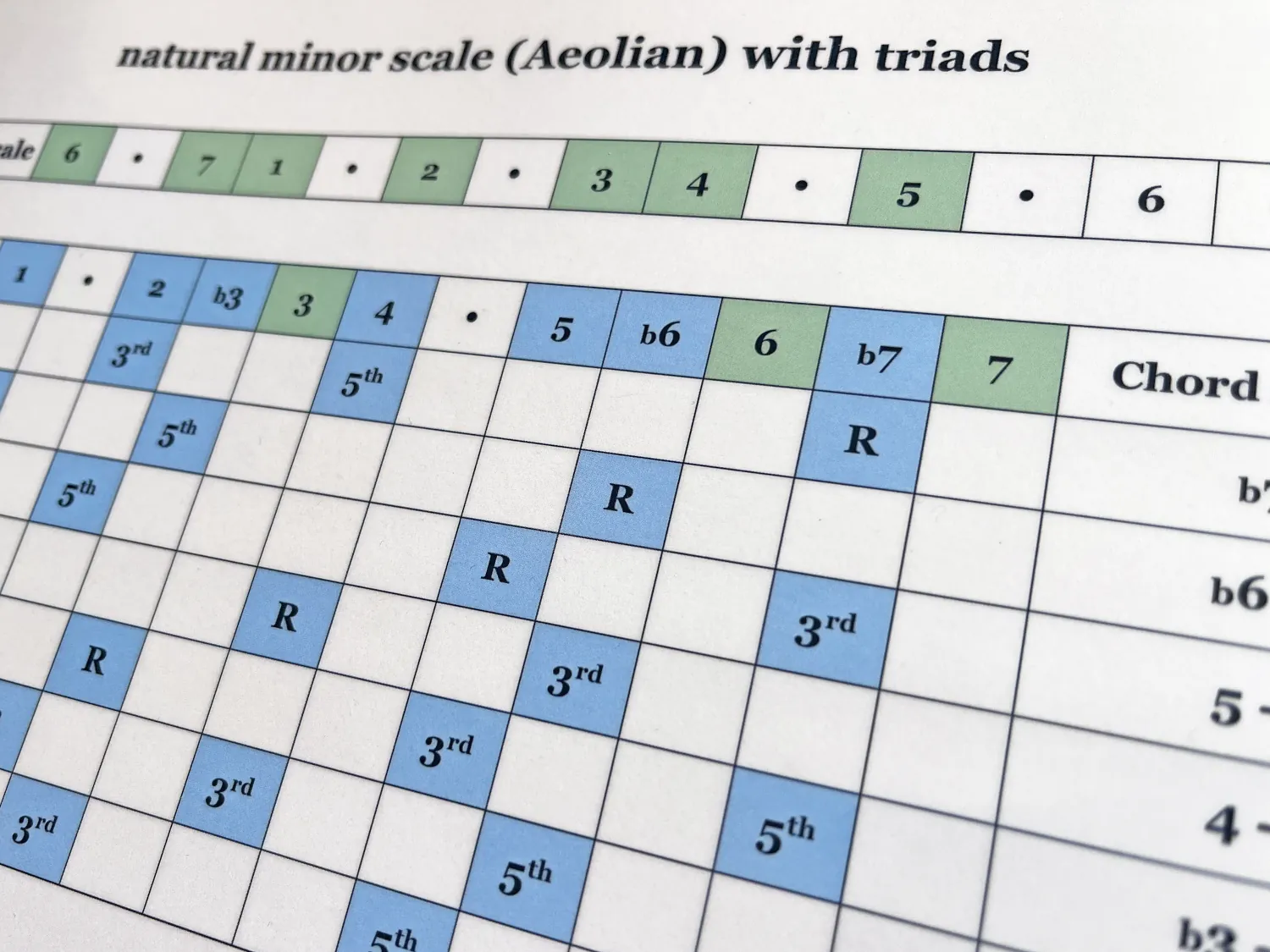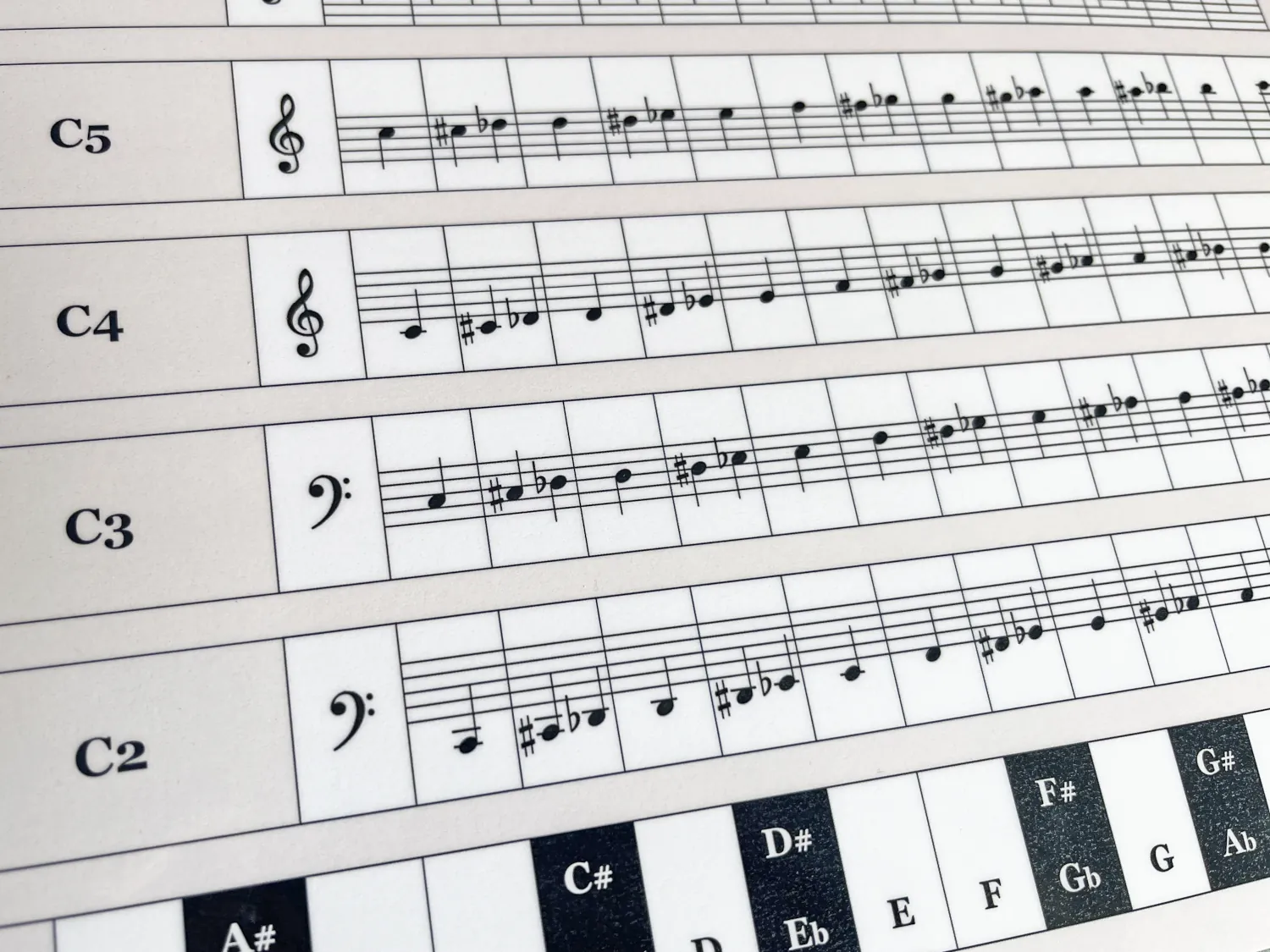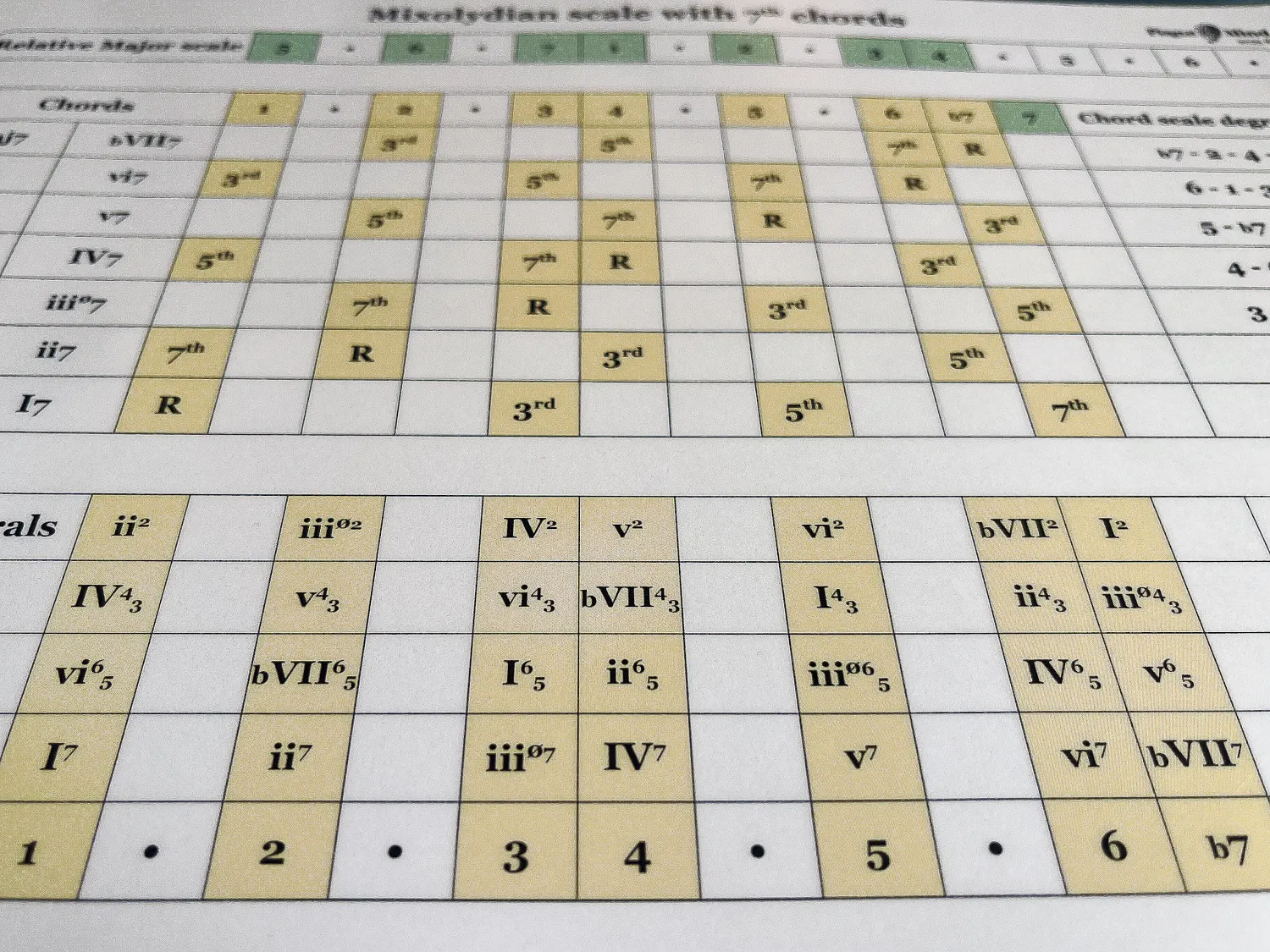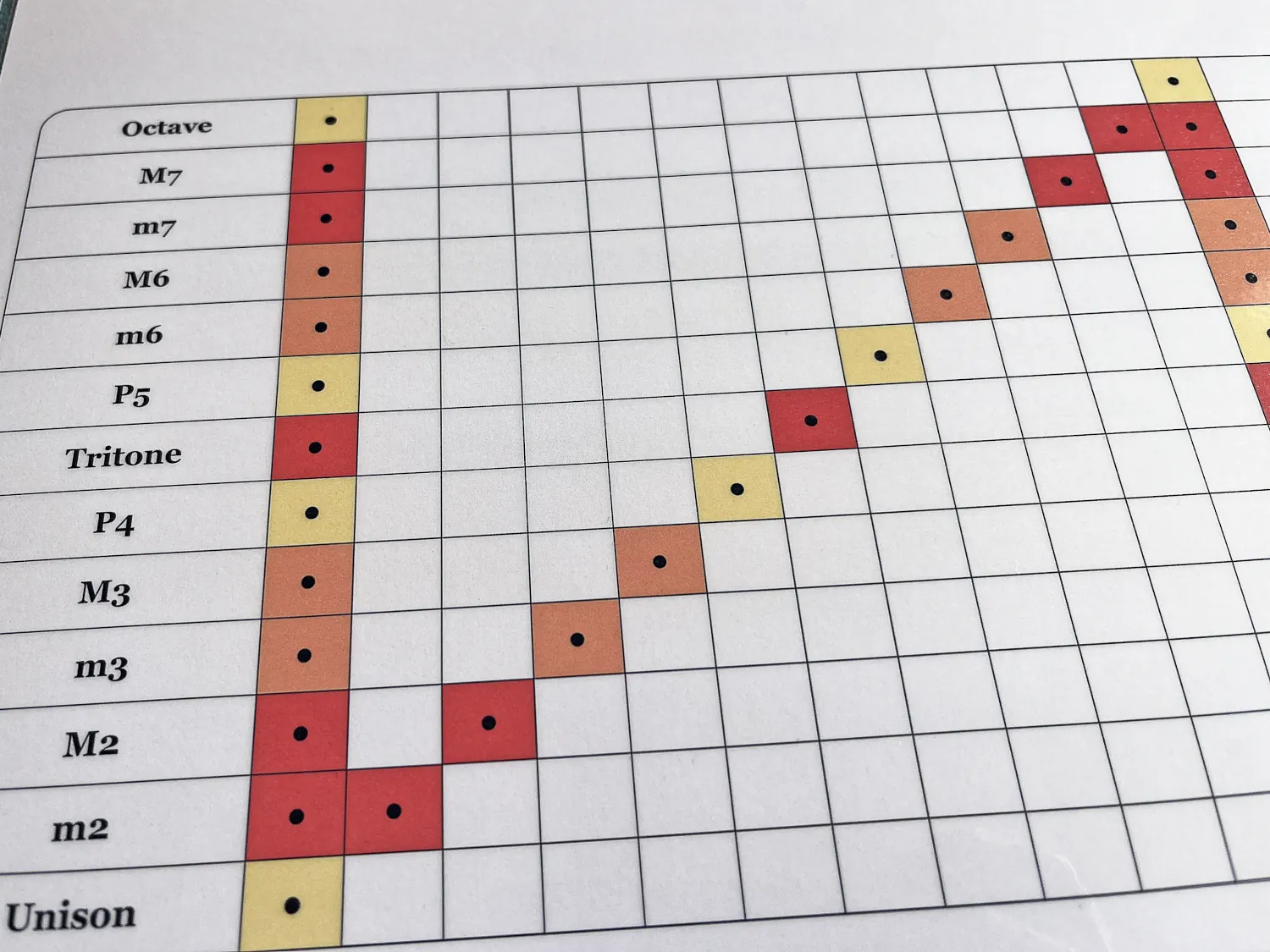Harmony Guide for Piano
A visual companion that helps you master intervals, chords and scales at the piano
Intervals
Chords
Scales
Chord structures
Roman Numerals
Scale degrees
What Is the Harmony Guide?
A practical set of visual reference cards designed to teach and support learning piano harmony — directly on your keyboard. No sheet music required. Just place the cards behind the black keys and explore chords, scales, and harmony at a glance.
How It Works
Column shows the keys
Each Harmony Guide card is built around the layout of a full octave, with 12 or 13 equal-width columns that align precisely with the piano keys. Each column represents a note, so when you place the card directly on the keys, behind the black keys, everything lines up visually. Chords, scales, and intervals appear exactly where they fall on the keyboard.
Rows shows harmonic contexts
Each row represents a harmony concept like a chord or scale. On the left is the name or symbol, the middle section shows colored cubes aligned to the piano keys indicating which notes belong, and on the right you’ll find extra info like chord functions or extensions.
Transposable by design
You can slide the card left or right across the keyboard to transpose it — the same harmonic structure applies in every key. This lets you practice and understand intervals, chords andscales, in all 12 keys using the same visual layout.
Flip to learn, memorize, and explore
Each card focuses on a specific concept — intervals, seventh chords, scales and more. Use it to learn and memorize musical structures, explore new scale ideas, or quickly confirm something you’re unsure about. It’s a handy visual reference that adapts to your practice needs.
Note: The Harmony Guide isn’t a theory book — it’s a visual reference that helps you learn theory directly on the keyboard. It shows you how chords, scales, and harmony actually look and feel under your fingers, making abstract concepts easier to understand through hands-on practice.
Grab Your Copy of the Harmony Guide
What’s on the Cards?
The Harmony Guide includes several types of cards, each focusing on a key aspect of piano harmony
1. Note Names with Staff Reference — showing key names alongside their position on the musical staff
2. Intervals — shows all 13 intervals from unison to octave, arranged so each interval is paired with its inversion, highlighting how intervals complement each other within the octave.
3. Chords — chord cards grouped by quality and including all inversions, with chord tones highlighted.
Chord types include:
- Major: Major triad, Major 7th, Dominant 7th
- Minor: Minor triad, Minor 7th, Minor-Major 7th
- Diminished: Diminished triad, Diminished 7th, Half-diminished (m7♭5)
- Augmented: Augmented triad, Augmented Major 7th, Augmented Dominant 7th
- Suspended 2: Sus2 triad, Major 7 Sus2, Dominant 7 Sus2
- Suspended 4: Sus4 triad, Major 7 Sus4, Dominant 7 Sus4
Chord cards also include chord formulas, chord structures shown by intervals, and some chords include possible added notes such as add2, add9, add11, and more.
4. Scales — includes Major, Natural Minor, Harmonic Minor, Melodic Minor, and Modal scales such as Lydian, Mixolydian, Dorian, Phrygian, and Locrian. Each scale is presented in two versions: one showing triads and another with seventh chords.
Each scale card features:
- Scale degrees numbered (1, 2, 3…)
- Roman numeral analysis for chords built on each degree
- Chord charts showing all seven chords of the scale
- Chord types constructed on the scale degrees and chord scale degrees
Additionally, all scales except the major scale display their relative and parallel major scales for easy comparison.
5. Mode Comparison — two pages offering a side-by-side comparison of modes and scales
The first page compares the 7 modes using numbered scale degrees and Roman numerals, showing their structure and harmonic functions.
The second page groups modes and scales by sound type (major, minor, and other) and also compares natural minor with harmonic and melodic minor, helping you understand their distinct tonal flavours.
Designed for Everyday Use
The Harmony Guide is printed on high-quality encapsulated sheets. Each card is printed in full color on both sides, then sealed in a durable, glossy laminate that protects against wear, moisture, and repeated use.
Unlike standard lamination, the edges are fully encapsulated — the plastic extends beyond the paper and is sealed all the way around. This gives the cards a sturdy, professional feel while keeping them flexible and easy to handle at the piano.
Compact design: fits comfortably on most acoustic and digital pianos. Simply place the card on the keyboard behind the black keys.
Note: Unfortunately, some acoustic pianos have structural features—like key lids that overhang—that prevent placing the cards directly on the keys. In these cases, you can use Blu Tack or a similar reusable adhesive to attach the cards to the body or underside of the piano.
Both — but with a few notes.
Total beginners who are not familiar with music theory may need some time to get used to the system. As they learn the theory alongside using the guide, they will understand more and more, making the Harmony Guide increasingly useful. For intermediate players, it’s the perfect companion — helping to clearly visualize harmony, connect theory to the keyboard, and boost improvisation skills. Advanced players also find it valuable for quick reference, modal work, and composition.
When you purchase the Harmony Guide, you’ll also receive a PDF file (Harmony Guide – Companion Booklet) with detailed instructions on how to use the cards. However, in short: the best way to use the Harmony Guide is as a learning and memorization tool for intervals, chords, and scales. Regular practice with the cards helps build your understanding and familiarity with harmony concepts. You can also use it as a quick reference while playing, improvising, or composing music. Over time, it will support your creativity and improve your piano skills by making harmony more accessible and intuitive.
We ship all orders from the UK. Delivery times typically are:
- UK: 4–7 business days
- Europe: 5–10 business days
- USA and other international locations: 7–14 business days
Please note these are estimates and actual delivery may vary due to postal service delays or customs processing.
The Harmony Guide is made using a high-quality print-on-demand service through a trusted third-party production partner. Each page is printed on premium sheets and finished with encapsulated lamination, which means every sheet is fully sealed in a durable, waterproof coating. This ensures the cards are sturdy, easy to handle, and long-lasting — perfect for regular use at the piano. Using print-on-demand also helps us keep the product affordable and reduces waste by producing each order fresh.
We take great care to package your Harmony Guide securely to avoid damage during shipping. However, if your order is lost or arrives damaged, please contact us within 7 days of receiving it at info@pianomind.com. We’ll work quickly to resolve the issue — either by sending a replacement or arranging a refund. Customer satisfaction is very important to us!
We currently ship to:
United States, Canada, United Kingdom, and most EU countries, such as:
Austria, Belgium, Croatia, Cyprus, Czech Republic, Denmark, Estonia, Finland, France, Germany, Greece, Hungary, Ireland, Italy, Latvia, Lithuania, Luxembourg, Malta, Netherlands, Norway, Poland, Portugal, Romania, Slovakia, Slovenia, Spain, Sweden, and Switzerland.
If you’re unable to add the product to your cart at checkout, it’s likely that we do not currently ship to your country.

